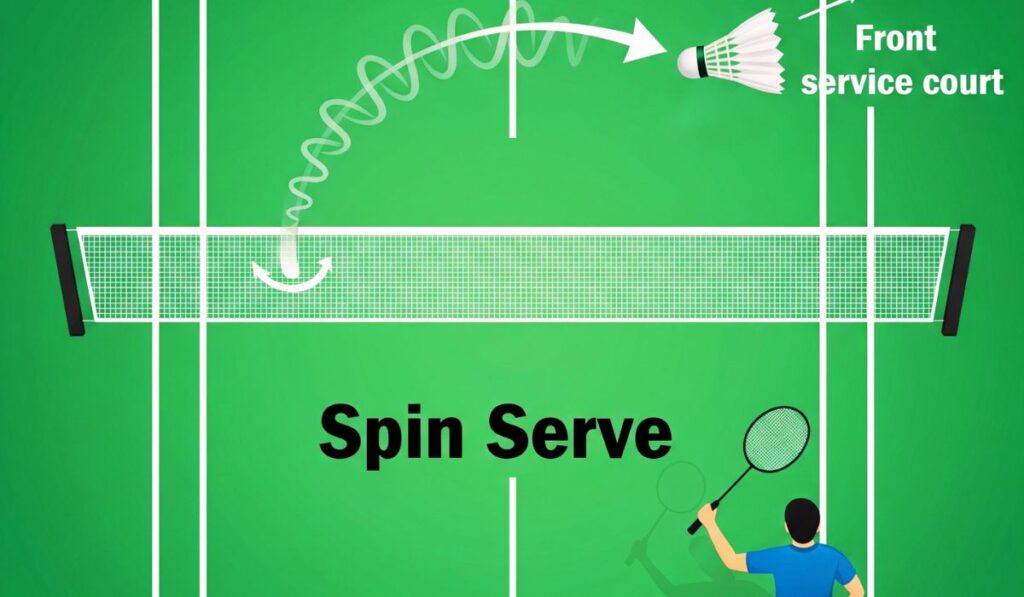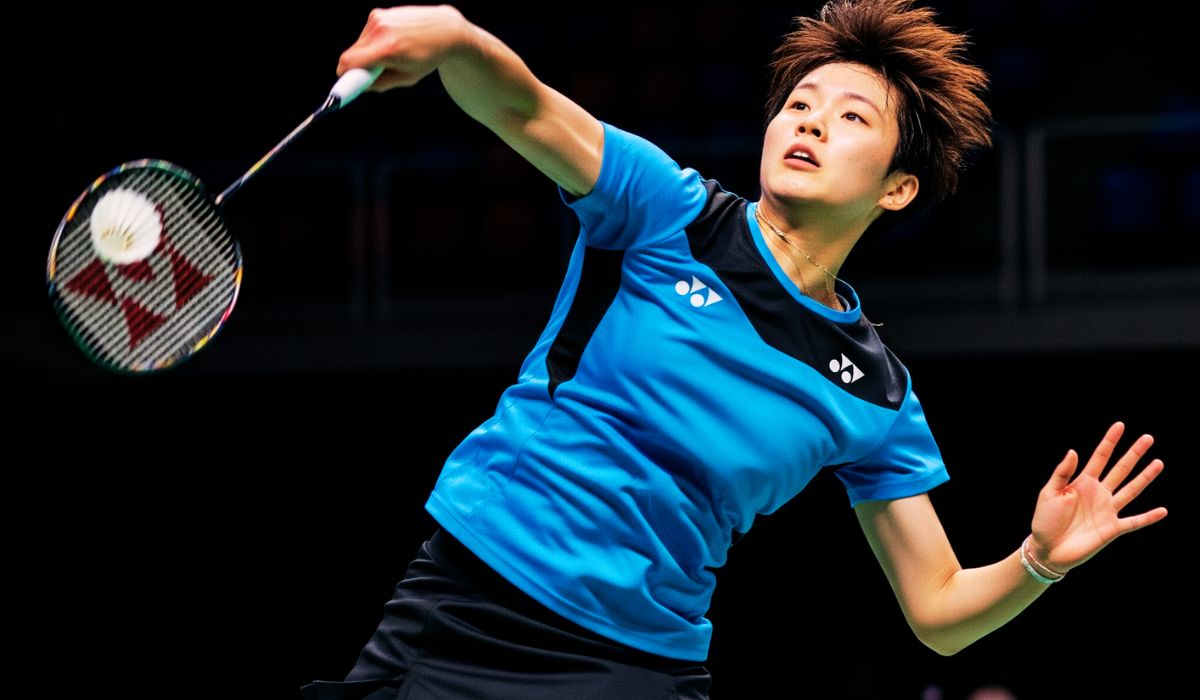“Badminton’s Spin Serve Ban: The Controversial Rule That Crushed Creativity But Saved the Game”
The Emotional Shockwave Behind the Badminton Spin Serve Ban
When the announcement came that the spin serve in badminton was officially banned, it didn’t just feel like another rule adjustment. For many players, it felt like a gut punch — a sudden ripping away of a technique that added thrill, unpredictability, and artistry to the game. It was the kind of move that had the crowd leaning forward, eyes wide, unsure where the shuttlecock might land next. And just like that, it was gone.
The Badminton spin serve banned wasn’t just a trick. It was a weapon. It was the sly wink of a player who knew they could manipulate not just the shuttle but also their opponent’s nerves. That gentle flick of the wrist, the almost hypnotic rotation of the shuttle in midair, the way it seemed to hang for a heartbeat before darting off in an unexpected angle — all of that made it irresistible to watch and infuriating to defend against. But in the eyes of the rule makers, it was also unfair.
Why the Spin Serve Was So Dangerous — and So Loved
Badminton has always been a game of precision, speed, and psychological warfare. The Badminton spin serve banned amplified every one of those elements. Imagine standing on the receiving end, your eyes locked on the server’s hand, your mind trying desperately to calculate the angle — but the shuttle twists like it has a mind of its own. That unpredictability was intoxicating for some, and a nightmare for others.
For players who mastered it, the spin serve was a source of pride. It took hours of training, countless failed attempts, and a sensitive touch that couldn’t be taught in drills alone. It was a craft. A dance between control and chaos.
The Ruling That Changed the Rhythm of the Game
In 2023, the Badminton World Federation (BWF) decided enough was enough. They declared that any form of Badminton spin serve banned imparted at the point of contact in the serve would be considered illegal. It was a decision rooted in fairness — the BWF argued that the technique gave too much of an advantage to servers, especially at the professional level, where matches could be decided by a handful of points.
To the rule makers, banning the Badminton spin serve banned wasn’t about crushing creativity; it was about preserving the balance between offense and defense. But to many players, especially those who had invested months into mastering the technique, it felt like the game had lost a piece of its soul.
The Echo of Silence After the Ban
When the news first broke that the badminton spin serve was banned, there was a strange silence that followed. It wasn’t the kind of quiet you experience in a stadium after a match ends—it was heavier, more personal. Players who had mastered the delicate art of the Badminton spin serve banned felt as though a piece of their badminton identity had been taken away. The air in practice courts shifted. The familiar whirring sound of the shuttle twisting through the air was gone, replaced by the dull thud of standard serves. It was as if the game had lost a flavor that only a select few could taste.

Why the Spin Serve Was More Than Just a Move
For many athletes, the Badminton spin serve banned wasn’t merely a tactical choice—it was an expression of personality. The subtle wrist flick, the precise control of the shuttle’s feathers, the hypnotic spin that danced midair before dropping unpredictably on the opponent’s side… it was poetry in motion. Banning it didn’t just remove a technique; it removed an emotional outlet. The artistry of badminton lost a brushstroke from its canvas, leaving many players wondering if the sport’s rules had forgotten the beauty within its complexity.
The Thrill That Once Was
Spectators used to lean forward in their seats the moment they sensed a spin serve coming. There was anticipation, a collective holding of breath, as if everyone in the arena shared the same heartbeat. When that shuttle spun, it wasn’t just a serve—it was suspense materialized. Now, with the ban in place, that electric pulse in the crowd feels dulled. The moments that once ignited gasps have been replaced with predictable, mechanical serves. The adrenaline rush has been tempered, and for fans, the loss is palpable.
The Emotional Fallout for Players
Imagine dedicating years to perfecting a skill, only to wake up and find it outlawed. Some players have likened it to losing a trusted weapon in battle. For them, the Badminton spin serve banned was not only about winning points—it was about setting the tone, playing mind games, and showcasing technical mastery. Without it, they feel stripped, exposed, and forced to reinvent their style. The emotional fatigue is real; adapting isn’t just about learning something new, it’s about mourning what’s been lost.
A Controversial Decision at the Heart of Badminton
The Badminton spin serve banned banned decision didn’t come without controversy. Governing bodies claimed it disrupted fairness and made rallies too unpredictable. Critics, however, argue that unpredictability is part of what makes badminton so gripping. They point out that every sport thrives on innovation, and banning a serve that requires immense skill sends the wrong message. For purists, this was not about protecting the game—it was about restricting its evolution.
The Sensory Memory of the Spin
Even now, in quiet gyms late at night, veteran players sometimes practice the motion in secret. They grip the shuttle, feel its feathered texture between their fingers, and recall the satisfying moment when it leaves their hand and twists through the air. They can almost hear the hiss of its spin, see the opponent’s startled eyes, and taste the victory that followed. These are memories carved deep into muscle memory, and no ban can erase them entirely.
Fans Divided Between Nostalgia and Acceptance
Some fans are resigned to the new era, embracing the cleaner, more straightforward serves. Others can’t let go of what the spin serve brought—a sense of danger, artistry, and unpredictability. Online forums are still ablaze with debates, old match clips circulate like sacred relics, and young players watch them in awe, wondering why such brilliance was outlawed. The ban has become more than a rule—it’s a cultural divide within badminton.
Coaches Forced to Redesign Strategies
For coaches, the ban on the badminton Badminton spin serve banned wasn’t just a technical hurdle—it was a strategic earthquake. Entire playbooks had to be rewritten. Players who built their game around the serve’s unpredictability had to develop entirely new opening tactics. This wasn’t just about replacing one skill with another—it was about reshaping identities. The serve is the heartbeat of every rally, and when you change the heartbeat, the entire game feels different.
The Lingering Ghost in Competitive Matches
Even in major tournaments today, you can sometimes see the shadow of the spin serve. A player might grip the shuttle in a way that suggests a spin, making their opponent tense up, only to deliver a standard serve. The ghost of the move still haunts the court—its psychological presence remains, even if the motion itself is gone. It’s proof that some techniques leave imprints far deeper than rulebooks can erase.
What Was Truly Lost
The Badminton spin serve banned decision wasn’t just about preventing a tricky shot—it took away a rare fusion of technical mastery and showmanship. In a sport where speed and precision already dominate, the spin serve added an extra layer of creativity. It was a reminder that badminton isn’t just about hitting harder or moving faster; it’s also about crafting moments that live in the minds of spectators long after the match ends.
Adapting Without Losing the Spirit
Despite the heartbreak, many players are finding ways to channel their creativity into other serves—deceptive flick serves, disguised low serves, and precise drive serves. The spirit of innovation is still alive, even if its most flamboyant expression has been silenced. In a way, the ban is forcing athletes to think deeper, dig into their resourcefulness, and keep surprising their opponents. The artistry is evolving—it’s just wearing a different costume.
A Generation That Will Never Experience It
Perhaps the saddest part of this ban is that young players growing up now will never get to experience the joy of learning and perfecting the Badminton spin serve banned in a legal match. They’ll only see it in old footage, like a piece of badminton folklore. It’s a reminder that sports are living histories, constantly reshaped by rules, culture, and controversy. What’s banned today may have been the pride of yesterday.
The Whisper of What Could Have Been
Every time a match reaches a high-tension moment—when the score is tied, the crowd is roaring, and the serve could decide the set—there’s a fleeting thought: what if the Badminton spin serve banned was still allowed? What twist of fate could it deliver? That whisper of possibility is gone, leaving players and fans with a bittersweet ache for the “what ifs” that will never play out.
The Roar of the Crowd and the Silence of the Ban
There was a time when the Badminton spin serve banned brought entire stadiums to life. A player would walk onto the court, twirl the shuttle with calculated grace, and in that single flick, the crowd would inhale sharply. Today, that collective gasp has been replaced by a quieter, more predictable hum. Without the spin serve, the audience feels a subtle void—an absence of the magic that once electrified the air.
Players Who Built Their Identity Around the Spin Serve
For some athletes, the Badminton spin serve banned wasn’t just a tool—it was their signature. Their career highlights are filled with moments when this serve toppled giants and stunned opponents into submission. With the ban, these players had to reinvent themselves, stripping away a part of their identity and finding a new rhythm, like a singer learning to perform without their favorite note.
The Element of Surprise That Changed Matches
The Badminton spin serve banned thrived on unpredictability. It was a psychological weapon, forcing even the most confident player to hesitate. Opponents never quite knew which way the shuttle would dance in the air. With its removal, that instant of doubt is gone, making rallies more structured, but perhaps a little less thrilling for those who crave unpredictability.
The Emotional Weight of Fairness
The Badminton spin serve banned wasn’t without reason. For players on the receiving end, the spin serve could feel unfair—a gamble they didn’t sign up for. Its erratic movement, often exaggerated by skillful deception, left little room for reaction. For these athletes, the ban wasn’t the death of artistry—it was the birth of balance.
Memories of Classic Matches
When fans look back, they remember matches where the Badminton spin serve banned turned the tide at the last possible second. The roar of victory, the slump of defeat—it all hinged on that one serve. Those memories now live in highlight reels and conversations, preserved like rare treasures from an era that will never return.
The Art in the Serve
Executing a perfect spin serve was never about luck. It was an art form—wrist precision, finger control, and timing so delicate it bordered on poetry. Players who mastered it spoke of the sensation as if painting a masterpiece with every flick of the shuttle.
The Thrill of Learning It
For aspiring players, the spin serve was a rite of passage. Learning it felt like unlocking a secret no textbook could teach. Hours were spent in dimly lit training halls, shuttles littering the floor, the sound of feathers slicing air again and again until the serve became muscle memory.
The Frustration of Facing It
On the flip side, there was nothing more maddening than being on the receiving end. Your eyes would track the shuttle, your racket ready—and in the blink of an eye, the shuttle would drop in a place you never expected. The frustration was real, but so was the respect for the opponent’s skill.
How It Shaped Training Styles
Coaches built entire training regimens around countering the Badminton spin serve banned. Footwork drills, reaction exercises, and anticipation tactics were all shaped by its existence. With the ban, training has shifted toward other priorities, but the ghost of the spin serve still influences how players prepare.
The Ban’s Impact on Young Players
For younger athletes who never got to try it in competitive play, the Badminton spin serve banned is almost mythical—like a move from a different generation. They hear stories, watch old footage, and wonder how their game might have been different had they grown up in the spin serve era.
The Debate That Still Burns
Even now, badminton forums light up with debates about whether banning the Badminton spin serve banned was the right call. Purists defend the artistry, while others argue for fairness and accessibility. It’s a conversation that refuses to fade, proving just how deeply the serve is woven into the sport’s culture.

The Subtle Shift in Game Tempo
Without the Badminton spin serve banned, matches have a slightly different rhythm. Rallies build more evenly, with fewer sudden bursts of chaos. Some find this steadiness more strategic; others miss the adrenaline rush of those unpredictable moments.
The Nostalgia Factor in Fan Culture
Badminton fans are sentimental. They share clips of legendary spin serves, often in slow motion, savoring the way the shuttle bends and twists. It’s a bittersweet nostalgia—part joy, part ache for what’s gone.
Innovation in Other Areas
The Badminton spin serve banned has sparked creativity in other parts of the game. Players are exploring new serve variations and tactics to fill the void. In a way, the absence of the spin serve has forced evolution, pushing the sport into fresh territory.
Emotional Resilience of Players
For athletes who relied heavily on the Badminton spin serve banned, adapting required emotional resilience. Losing a trusted weapon can feel like starting over, but many have emerged stronger, their game more versatile and their confidence rooted in adaptability.
The Psychological Shift in Competition
The absence of the Badminton spin serve banned changes how opponents read each other. Instead of bracing for the unpredictable, players can focus on positioning and technique. It’s a subtle but profound shift in mental preparation.
Spin Serve as a Cultural Symbol
Beyond technique, the Badminton spin serve banned became a cultural symbol—representing rebellion, creativity, and the daring to challenge norms. Its ban feels, to some, like the sport closing a door on a wilder, more daring chapter.
The Legacy That Will Never Die
Rules may change, but legacies endure. The Badminton spin serve banned lives on in stories told by veteran players, in grainy match footage, and in the hearts of fans who witnessed its beauty. Even in its absence, it continues to inspire awe, frustration, and respect—emotions that define why we fall in love with sport in the first place.


2 thoughts on “Badminton spin serve banned”